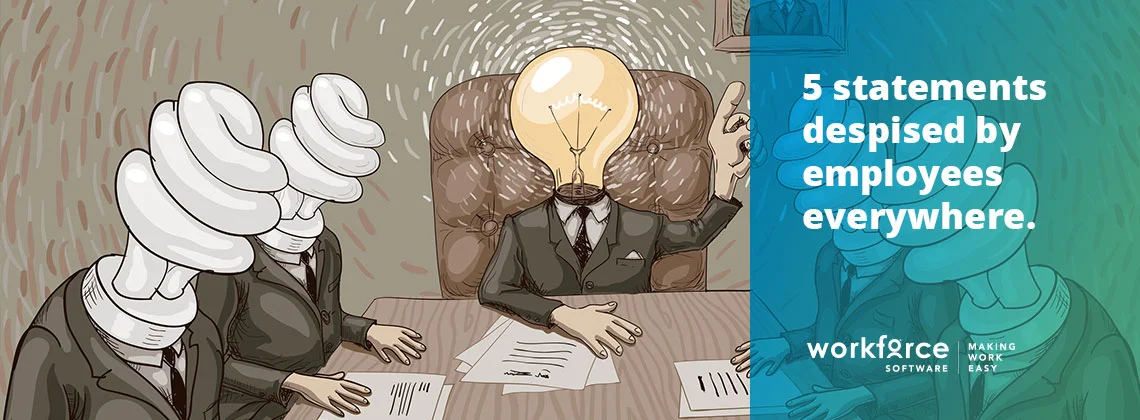This article was originally published on The WorkForce Blog.
Drip.
Drip.
You hear that?
Drip …drip.
That’s the sound of sweat, falling from the chin of an employee who’s heard his last dismissive excuse at work.
His treadmill gradually slows down, then cuts out with a jerk.
Drip …drip.
He gets off, taking his towel with him. He walks a few slow steps to let his legs adjust to the stable ground. He wipes off his face and checks his watch. He’s not thinking about work at all. He doesn’t care anymore and he knows it.
What not to say at work:
Unless you’d like to categorically disturb and disengage your employees (or colleagues, for that matter) refrain from ever dropping these lines at work.
Even if the phrase fits, there’s a better way to put it. A way that doesn’t do someone in, robbing them of their last shred of engagement.
Here’s the worst of the worst—as well as some emotionally intelligent alternatives:
1. “Sorry, I don’t make the rules.”
If you work for a corporation, you’re probably not lying: many of the “rules” have already been folded and neatly packaged for you—but most people who complain to you probably understand that.
They understand that embedded processes and rules can’t change overnight. They require time and effort and collaboration to amend. More importantly, most people who air a grievance aren’t expecting their managers to single-handedly fix the issue. Not at all…
But they are expecting them to listen, to think critically about their point of view.
A better alternative to “Sorry, I don’t make the rules…” would be:
“What would you suggest we do differently?”
Inciting change takes courage, which takes energy and confidence to muster. That’s why suggestions shouldn’t be shut down; complaints shouldn’t be dismissed. Not only is it demoralizing, it’s rude.
Asking “What would you suggest we do differently?” lets people know you’re listening. It reinforces the notion that everyone’s opinion is valid, because it is.
2. “You’re not here to have a good time.”
Regardless of the job, an employee’s purpose at work is to support the goals of their manager. And that manager’s job it is to supporttheir manager’s objectives, and so on and so forth, all the way up the troth to the CEO, or wherever the buck stops.
That’s how companies turn a profit: everyone does their part.
That said, greeting success with more work can be exhausting. You know this. So, how can you walk that productivity line with your employees?
A better alternative to “You’re not here to have a good time…” would be:
“What are we celebrating?”
There’s nothing wrong with playing ping pong or socializing, checking Facebook or watching a YouTube video, as long as it’s deserved.
Asking “What are we celebrating?” lets people know you’re all for having good time, as long as it’s earned.
3. “That’s how we’ve always done things.”
Playwright, George Bernard Shaw, said it best:
“Progress is impossible without change, and those who cannot change their minds cannot change anything.”
A better alternative to “That’s how we’ve always done things…” would be:
“How did you do it at your last job?”
Because processes ought to be dynamic, ever-changing. Leaders who don’t take time to objectively reevaluate how and why they do things will, inevitably, find themselves stagnant and unproductive.
Asking “How did you do it at your last job?” tells people you’re open to change.
4. “Figure it out.”
This sweep-it-under-the-rug response puts employees in a stressful, often hopeless, position.
As a manager, it’s better to take a step back and understand the circumstances. Why is your employee asking for help in the first place? Is he or she incompetent or are your expectations unreasonable? Is he or she being lazy or is the problem legitimately beyond their scope?
A better alternative to “Figure it out…” would be:
“Let me help you.”
Helping is about more than fixing a problem. Helping is an opportunity to coach, mentor, and develop.
Helping creates a win-win scenario.
5.“That’s not my problem.”
Both cruel and careless, this statement is the antithesis of collaboration. It shows a complete disregard for the problem as well as the individual working to solve it.
A better alternative to “That’s not my problem…” would be, once again:
“Let me help you.”
Because your employees’ problems are your problems.
Can’t help in that very minute? That’s fine—just schedule a time to do so, or see if someone else can lend a hand sooner. As long as you’re receptive, eager, and engaged, you’re in the right.
Final Thought:
Behind every engaged employee is a responsive, stable manager. A manager that’s receptive to new ideas, concepts, and practices. A manager that respects each employee’s unique point of view.
Be flexible, be encouraging. Listen like your professional relationships depend on it—because they do—and expunge these statements from your rhetoric. You’ll be a better manager for it.


